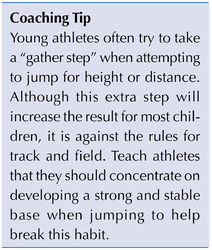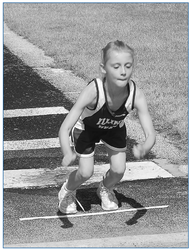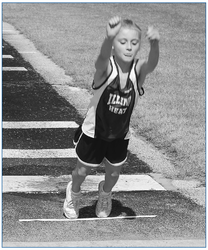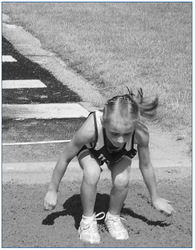 When an athlete is preparing to execute the standing long jump, the athlete’s feet must be fixed in a parallel position. The jumper may rock the toes and heels off the surface, but the feet cannot be lifted completely off the surface before the jump. The athlete rocks the arms back and forth and bends at the knees and hips to set up the appropriate rhythm and body position for a good jump.
When an athlete is preparing to execute the standing long jump, the athlete’s feet must be fixed in a parallel position. The jumper may rock the toes and heels off the surface, but the feet cannot be lifted completely off the surface before the jump. The athlete rocks the arms back and forth and bends at the knees and hips to set up the appropriate rhythm and body position for a good jump.
To begin the jump, the athlete swings both arms forcefully forward in unison, as shown in figure 9.2a, and blocks—or stops—them slightly higher than the shoulders, with a slight yet firm bend at the elbow. Both feet must leave the ground at the same time so that a full extension of the ankles, knees, and hips—also called triple extension—must be achieved in order to use all potential energy from these joints (see figure 9.2b).
Just as the athlete is about to land, the feet should be as far in front of the body as possible without causing the athlete to lose balance and take a backward step after landing. To get the feet to move forward, the arms whip back to the hips. This helps kick the feet out in front. On landing, the athlete should try to absorb the impact by bending at the knees and hips (see figure 9.2c).



9.2a 9.2b 9.2c